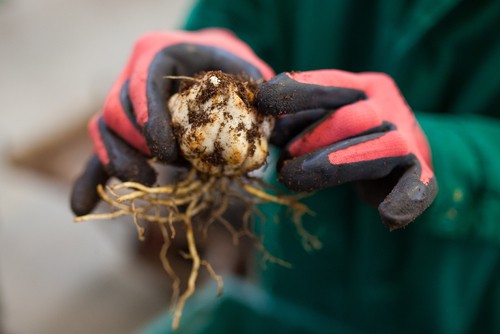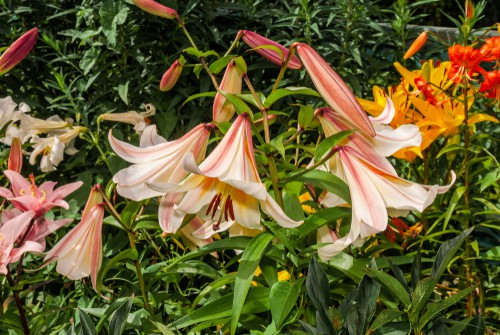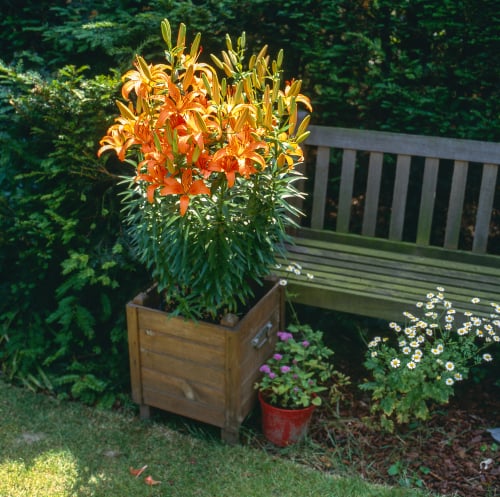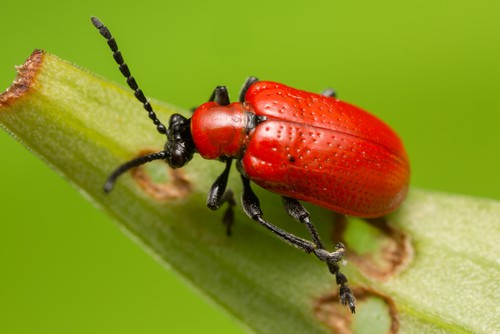Last updated on March 23rd, 2022
Our site is reader supported, this means we may earn a small commission from Amazon and other affiliates when you buy through links on our site.
Lillies can be one of the most exciting plants to grow from bulbs. They can grow to be particularly large and aromatic, making them a stunning and popular garden addition. Of course, if you are planning on having any Lillies in your home you can choose to purchase pre-started Lillies or alternatively, grow them from forced bulbs. Lillies prefer well-drained soil in a sunny spot, so if you have clay soil that is often waterlogged it can be better to grow them in pots and place them around your borders.
Planting Lily Bulbs

Plant in full sun, although some varieties prefer light shade
Before you begin planting it’s important to pick the right location. Lillies are perennials which means they will come back every year. Take into consideration where you want Lillies to reappear time and time again in your garden and select an area where they won’t be disturbed. If you want to grow very specific colours, like pink, they will grow much more vibrant in light shade, so you might want to find a location with light shade. Most Lillies, however, will grow well and prefer to be planted in full sun.
Spacing Lillies and planting depth
The next consideration is spacing, especially if you’re going to grow more than one. Most people grow Lillies in small clumps, three or four together in one area so that they make an impact and are not just dotted around. Of course, you can spread them out into individual beds and borders having them flourishing in between other plants.
No matter how many you plan to put together, dig a hole for your group that is at least 20cm deep. If you’re going to plant a lot of them nearby it might be better to simply dig one long trench rather than multiple holes and then drop them in, where you want them to be, filling in the space around them.

Add a layer of grit to the bottom of the hole or trench, underneath the bulbs for improved drainage
In the holes or the prepared trench, add a layer that is approximately 5cm thick with grit. Drainage is particularly important and your Lillies will flower much more effectively and live significantly longer if they have their feet in the shade but the flowers in the sun, and are planted in soil that is free-draining because they hate to be in waterlogged soil.
When to plant Lily bulbs
In terms of when to plant, you can plant Lillies at any point during the autumn, the winter, or the very beginning of spring. As long as you get them in the ground before March they will do just fine.
How to place Lillies in ground
When you place them in their respective holes make sure the pointy end is facing upright. If your bulbs already have a sprout and its curved, don’t worry they will be just fine. You can simply place the sprout just above ground level. Within a few weeks, they will straighten themselves out.
Mark where they are planted to avoid accidentally digging them up
It might do you some good to mark where you have planted them in your garden so that when they are not in season you won’t accidentally dig them up or harm them, this has been my mistake in the past when weeding or planting other plants.
Once they are in place it’s important to protect them against slugs, which will probably be the biggest nuisance you will face, however, the Red Lily Beetle can be a big problem too, which we will discuss a little further down.
Planting in Containers
If you are growing your Lillies from bulbs you can, of course, plant them in containers. Use a loam-based compost such as John Innes potting compost and mix in some grit with the compost and feed every two weeks with a liquid potash feed during the growing season.

Otherwise, the same general spacing and depth rules apply in a container as they do in the ground.
Watch out for Lily Beetles
Once you have planted your Lillies in bulb form, be on the lookout for the Lily Beetles as the Lillies start to shoot through the soil. The Lily Beetle will appear on the foliage and flowers in spring and will often strip away every bit of foliage leaving the stems bare, they will even eat the buds and flowers. When you see them, remove them by hand, it’s well worth checking daily because they can do so much damage in such as short period of time.

They are most active in April and May so keep your eyes peeled. You can also look out for the grubs before they turn into beetles and they usually hide on the underside of the leaves, the grubs to eat the leaves, and these are best controlled with a pesticide.
Taking Cut Flowers
Once your flowers start coming in you can, of course, cut them and bring them inside. Just make sure you leave enough of the stem and the foliage so that the plant is able to continue photosynthesis and store energy for dormancy.
What to do After they have Finished Flowering
Once they have finished flowering it’s important to remove the spent flowers and seed pods and then wait until the stems turn yellow and brown in autumn and die back naturally. At this point, you can cut them back to soil level but not before. If you cut back the foliage too soon, this can weaken the bulb and it may not flower the following year.
Click here to learn more about what to do with Lillies after they have finished flowering


